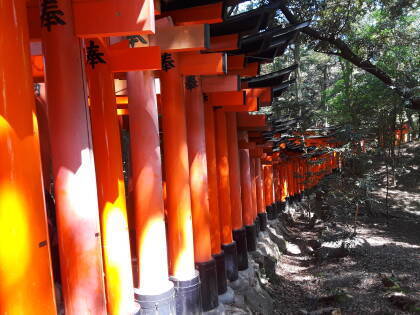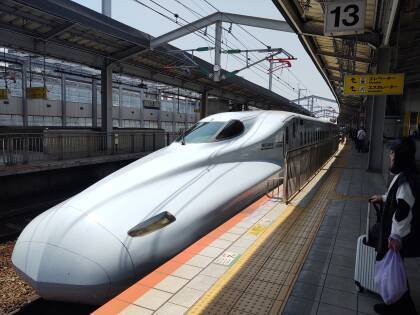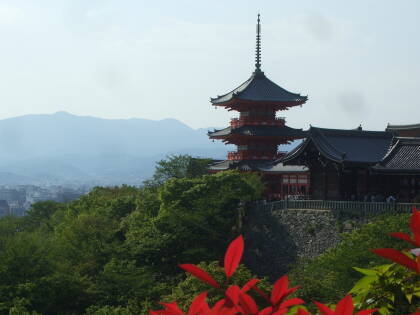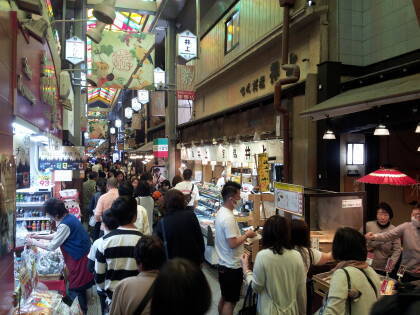
Shinkansen to Kyōto
By Shinkansen To Kyōto
I had been staying in
Ōita
while exploring north-eastern Kyūshū with its
prehistoric tombs,
World-Heritage
cliff-carved Buddhas,
and Japan's
largest active volcano.
Now I would take a Limited Express train to Kokura Station
in the city of Kita-Kyūshū,
and then a Shinkansen onward to
Kyōto.
Google Maps dynamically generates the map when you load this page. Depending on what time it is in Japan, you may see buses by a different route instead of my rail trip from Ōita Station to Kokura Station by Local Express, then by Shinkansen to Kyōto Station.
Traveling to Kyōto on Multiple Trains
I had researched schedules, and then purchased my ticket the evening before. I could sleep in, then do the ten-minute walk to Ōita Station mid-morning.
At the station, I was ready to feed my tickets into the barrier and pass through.

This would be my longest and most expensive train journey for this trip. You get a stack of paperwork, the three tickets shown below plus a receipt on a longer piece of the same magnetic-back cardstock.
The end-to-end ticket is at the bottom. It's good for travel from Ōita to Kyōto, generally speaking. That is, I could use it for a local train from somewhere in Ōita to its central station, from there to the central station in Kyōto, and then a local train to somewhere in Kyōto. But at both ends I was staying at places that were walking distance from the central stations.
The other two cards are for the supplemental charges, a Limited Express from Ōita to Kokura Station, and a Shinkansen from there to Kyōto. You simply feed the entire stack into the ticket machine, arranged in any order and orientation. The machine figures it out, and you pull your tickets out of the other end of the machine.
You do the same thing when you arrive, and the machine retains what's finished. As I left the Shinkansen section of the Kyōto Station, it kept the two supplemental tickets. Then as I passed outward through a second set of barriers to exit the Kyōto Station, it kept the end-to-end ticket. If I had changed to a local train in Kyōto, the end-to-end ticket would have been retained at the station where I exited the system.

Local trains stop at every station, and are aimed at commuters or people otherwise traveling to and from small local stations.
Express trains are similar, maybe skipping a few stations and traveling faster between stops.
Limited Express trains only stop at larger station.
Shinkansen means "New Trunk Line", and is shown as Super Express in English on tickets. Shinkansen lines have their own Express, Semi-Express, and Local services with varying numbers of station stops, and region-specific service names. Simplifying somewhat, to the southwest of Tōkyō, Nozomi and Mizuho are the Express service, Hikari and Sakura are Semi-express, and Kodama is Local. I had selected a Nozomi Express train, the Shinkansen supplement would have cost less for Semi-express or Local.
This is the Sonic Limited Express to Kokura Station.


The nice wood floors are relatively easy to clean.

Soon we were traveling along the coast highway from Ōita through Beppu, the city of many "Hells" or clusters of hot springs.

We continued north through a productive agricultural area. We were traveling well below Shinkansen speeds, but this was much faster than most Amtrak trains in the U.S. I'm accustomed to 100 km/h being top speed on a train.

Continuing to Kyōto on the Shinkansen
I had planned the day's travel to give me plenty of time at the Kokura Station. It wasn't as if I were familiar with that station, and the signage for all the platforms and trains can be somewhat overwhelming. Besides, I wanted to buy a bentō lunch for the second leg of the journey.
I noticed the schedule for the Super Express, the Shinkansen running north from this station toward Hiroshima, Ōsaka, and Tōkyō.
From 6 AM to 9 PM at least four, and up to seven, high speed trains depart this station toward the northeast. Each of them has from eight to sixteen cars and travels at speeds up to 320 km/h.
Where I live, near a station on an Amtrak route joining New York City and Chicago, there are only three trains in each direction every week. Between my home and Chicago it can hit a top speed of about 100 km/h, but toward New York, it's limited to about 60 km/h through segments of the route through West Virginia.

Several shops within the Shinkansen zone of the station offered karasumi, a distinctive specialty of northern Kyūshū. It's the result of salting a mullet roe pouch and drying it in sunlight. The roe sac is deveined and then repeatedly pressed, dehydrated, and salted. Along with sea urchin and konowata or fermented sea cucumber intestines, karasumi makes up Japan's three primary Chinmi, "rare tastes" or delicacies.
I didn't want an all-karasumi lunch, but I did want a bentō that included some. One last taste of Kyūshū on my way northeast.

In Chicago's Union Station, you have to struggle to understand boarding announcements rendered almost entirely unintelligible by echoes and distortion. Then you stand in a long serpentine line and wait for Amtrak staff to escort all passengers, as if they are dim-witted and somewhat self-destructive children, out to the track. As I write this, my return from my most recent visit to Chicago involved walking past five electronic displays purporting to show the time. One of them seemed to be correct or nearly so, the others were randomly off by up to eight hours in either direction. The U.S. has pitiful infrastructure.
In Kokura Station, supplied with a bentō lunch, I went to the appropriate platform and found the place to stand to board my car. My seat was in car 11 of a 16-car train.

I went to Platform 13 and found where car #11 would board. I stood off to the side because a Shinkansen terminating at Shin-Ōsaka would stop here at 12:39, before mine at 12:52. The 12:39 train has just come into view in the distance.

Here it comes. The white-and-green sign on the platform indicates where car #7 of an 8-car train stops.

The Shinkansen became known as the "Bullet Train" because the original design in the 1960s had a rounded nose. Now they are much more sleek and futuristic.
This train and the following one which I would take were the N700 series.

It stopped for just three or minutes to let passengers off and on. You have to be ready to board and disembark quickly. There it goes, continuing northeast. The N700 series reaches 270 km/h in just three minutes.

My Shinkansen to Kyōto
Here's my train. Notice the white-and-yellow sign showing 11 on the platform.

Yes, car #11 of a sixteen-car train, its door precisely aligned with the 11 sign on the platform.

Step on board, turn left, and find my seat. I had asked for a window seat.

Bentō Unboxing
At Chicago's Union Station, there's a McDonald's where you could buy a greasy and rapidly cooling meal for US$ 10.69 and up.
On board an Amtrak train in the U.S., you could go to the Cafe Car and get a hot dog and a can of beer for US$ 12.50.
I paid the equivalent of about US$ 10.50 for this bentō and a drink.

The lid of the box held a moist towel or oshibori, and chopsticks or hashi.

There's a lump of karasumi, between edamame and pickled vegetables.


There was a piece of grilled fish, more pickled vegetables and some steamed ones, a meat ball dumpling, and a piece of panko-breaded pork.

The karasumi was ready for its closeup. Outside the window, we had immediately passed through the tunnel under the Kanmon Strait separating the main islands of Honshū and Kyūshū. Then we were zipping through Honshū. In about two and a half hours we arrived in Kyōto and I disembarked.

Arrival in Kyōto
Guesthouses at Booking.comI had walked from the station to K's Place, where I had a bed reserved in a shared room. That evening I returned to Kyōto Station to get dinner.
It's Japan's second-largest station building, and one of the largest buildings over all. Looking at its north side, it incorporates a large hotel on the left, a large department store on the right (and continuing multiple levels underground beneath the entire plaza), and many shops and restaurants inside.

Standing on the plaza outside the station, you can turn back and see the Kyōto Tower.


Inside, the station is like something out of a William Gibson novel.


One of the upper floors has several ramen shops. You make your choices and pay at a panel in the passageway, then give your food and drink tickets to the staff as you enter.


I had read that craft breweries had become popular in Japan, especially in Kyōto. The Kyōto Beer Lab was close to where I was staying, so I checked it out.

Yes, they make the beer in the back, and the staff is local. But Kyōto gets a swarm of western visitors and they frequent places that are Japanese approximations to U.S. businesses. American Beer Bros congregate and discuss how similar things are to places back home. The resulting atmosphere isn't very Japanese. Just look at all the English signs and labels!
No, I needed an izakaya, a Japanese tavern.

A Local Izakaya in Kyōto
Back at K's Place, a woman at the desk told me about Raicho Shrine. I didn't even have to cross a street — turn left out the door of K's Place, left again at the main street, then look for the small building with an orange neon torii on the side just before crossing over the canal.


It actually includes a small shrine in the back. Upstairs is a room with tables, but right in off the sidewalk is a bar with five or six seats.
The front of the menu had the only English in the place, announcing the name and their specialty of spicy grilled chicken.

They quickly set me up with an Asahi, cold and crisp and very much in the Japanese style.
Also in the Japanese style, since I had already eaten dinner that evening, they suggested a snack of pickled vegetables. "Don't be English", as they say, don't recklessly drink without eating something.

I returned for dinner on other evenings. The spicy chicken is excellent. You eat it with kitchen shears and chopsticks, and varieties of pepper are available for further spiciness.


Choose your next stop around Kyōto:
Or, somewhere else around Japan:








































